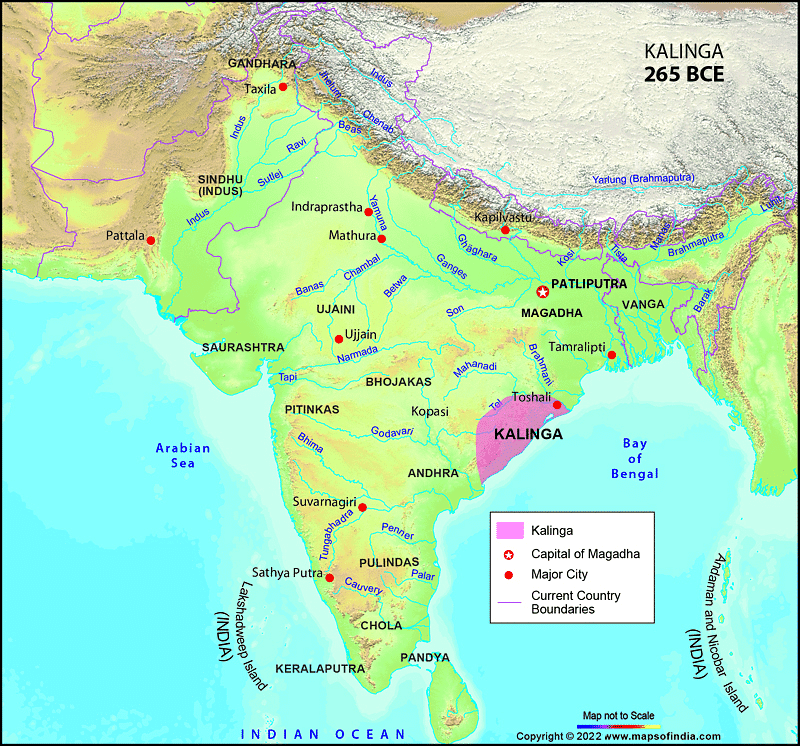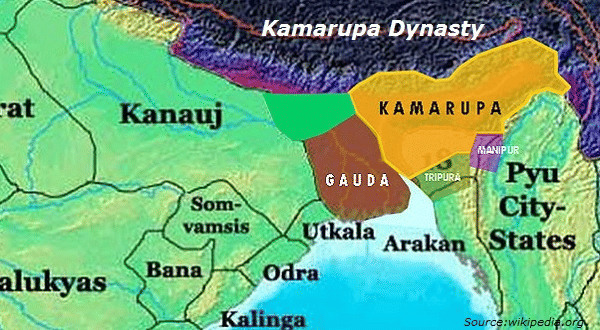Old NCERT Summary (RS Sharma): Spread of Civilization in Eastern India | History for UPSC CSE PDF Download
| Table of contents |

|
| Signs of Civilization |

|
| Orissa, and Eastern and Southern Madhya Pradesh |

|
| Bengal |

|
| Assam |

|
| The Formative Phase |

|
Signs of Civilization
- Civilization Criteria: A region is deemed civilized if its people possess writing skills, establish a tax collection system, maintain order, form social classes, and produce specialists for various functions. Most importantly, a civilized society can generate enough resources to sustain not only the producers, such as artisans and peasants, but also consumers who are not involved in production.
- Historical Context: In many parts of eastern India, the elements of civilization appeared in a recognizable form relatively late. Written records are scarce in large areas of eastern Madhya Pradesh (MP), Orissa, West Bengal, Bangladesh, and Assam before the mid-fourth century AD.
- Economic and Social Development: Between the fourth and seventh centuries, there was significant progress in rural economy, state systems, and social class formation in eastern MP, Orissa, eastern Bengal, southeast Bengal, and Assam. This is evidenced by the presence of numerous Sanskrit inscriptions from the Gupta period in these regions.
- Sanskrit Inscriptions: Many inscriptions from the Gupta era, often in the form of land grants, were made by local rulers for religious purposes, benefiting brahmanas, Vaishnavite temples, and Buddhist monasteries. These institutions played a crucial role in spreading and reinforcing advanced cultural elements.
- Regional Survey: Understanding this historical process involves surveying different regions to grasp the development of civilization and culture during this period.
Orissa, and Eastern and Southern Madhya Pradesh

Kalinga's Historical Significance
- Located south of the Mahanadi in what is now coastal Orissa, Kalinga rose to prominence under Ashoka, despite having a strong state established there as early as the first century BC.
- The region was ruled by Kharavela, who expanded his influence into Magadha.
- During the first and second centuries AD, Orissa's ports were active in trade, dealing in pearls, ivory, and muslin.
Trade and Archaeological Findings
- Excavations at Shishupalgarh, the site of Kalinganagari and Kharavela’s capital, revealed Roman artifacts, indicating trade connections with the Roman Empire.
State Formation and Conquests
- Despite the trade activity, much of northern Orissa did not experience significant state formation or commercial growth.
- In the fourth century, regions like Kosala and Mahakantara were recorded as conquered by Samudragupta, encompassing parts of northern and western Orissa.
- From the late fourth century to the sixth century, various states emerged in Orissa, with at least five identifiable.
The Matharas and Other States
- The most notable of these was the state of the Matharas, or Pitribhaktas, who at their height controlled the area between the Mahanadi and the Krishna Rivers.
- Adjacent states included the Vasishthas,Nalas, and Manas.
Taxation and Administration
- Each state developed its own systems of taxation,administration, and military organization. The Nalas and possibly the Manas also created their own coinage systems.
- These kingdoms supported the brahmanas with land grants, inviting them from outside, and many kings performed Vedic sacrifices for spiritual merit, power, prestige, and legitimacy.
Culture and Economic Practices
- Advanced cultural elements were not limited to the coastal region of Kalinga but were evident throughout Orissa.
- The discovery of Nala gold coins in the tribal Bastar area of Madhya Pradesh suggests an economic system where gold was used in large transactions and as payment to high officials.
- The issuance of copper coins by the Manas indicates the use of metal money by artisans and peasants.
Economic Expansion and Agricultural Development
- States expanded their income by creating new fiscal units in rural areas.
- The Matharas established districts like Mahendrabhoga and Dantayavagubhoga, the latter supplying ivory and rice-gruel to its administrators despite being a less developed area.
- The Matharas also made agraharas, which were land and income endowments from villages to support the religious and educational activities of the brahmanas.
Changes in Timekeeping and Writing Practices
- Under the Matharas in the mid-fifth century, the practice of dividing the year into twelve lunar months began, reflecting a better understanding of weather conditions beneficial for agriculture.
- Writing was known in coastal Orissa since the third century BC, with inscriptions up to the mid-fourth century AD in Prakrit. From around AD 350, Sanskrit became more widely used.
- Sanskrit inscriptions appeared outside the coastal area, indicating the spread of writing and the Sanskrit language across much of Orissa.
Sanskrit and Cultural Integration
- Sanskrit became the medium for brahmanical religion, culture, property laws, and social regulations in the new areas.
- Charters included verses from the Puranas and Dharmashastras, with kings claiming to uphold the varna system.
- The connection of the local people to the culture of the Gangetic basin was emphasized, and significant places like Prayag became important for victorious kings.
Bengal
Bengal during Ashoka's Reign:
- Parts of north Bengal, now in Bogra district, show evidence of writing during Ashoka's time.
- An inscription reveals settlements with storehouses for coins and food grains to support Buddhist monks.
- Local peasants could spare some of their produce for taxes and gifts.
- People in this area knew Prakrit and practiced Buddhism.
Coastal District of Noakhali:
- An inscription from Noakhali in south-east Bengal indicates knowledge of Prakrit and the Brahmi script in the second century BC.
- However, for most of Bengal, there is little evidence until the fourth century AD.
Fourth Century Developments:
- In the middle of the fourth century, a king titled 'maharaja' ruled in Pokharna, Bankura district.
- This king was a Sanskrit speaker and a devotee of Vishnu, possibly granting a village for Vishnu worship.
Fifth and Sixth Centuries:
- The area between the Ganges and Brahmaputra, now Bangladesh, became settled and fairly Sanskrit-educated.
- Gupta governors, becoming independent around AD 550, occupied north Bengal.
- Local vassal princes, samanta maharajas, built their own administrative and military systems.
By AD 600:
- The region came to be known as Gauda, an independent state ruled by Shashanka, an adversary of Harsha.
Pundravardhanabhukti Documents:
- From AD 432-3, land sale documents in Pundravardhanabhukti (mostly now in Bangladesh) indicate land purchases with gold coins called dinara.
- Land given for religious purposes was tax-exempt.
Local Administration:
- Land transactions involved scribes, merchants, artisans, and the landed classes.
- Local administration was managed by governors appointed by Gupta emperors.
Expansion of Agriculture:
- Land purchased for religious endowments was often fallow and untaxed.
- Grants aimed to bring such plots under cultivation and settlement.
Samatata and Vanga Kingdoms:
- Deltaic Bengal, formed by the Brahmaputra and called Samatata, acknowledged Samudragupta's authority in the fourth century.
- By AD 525 onward, a well-organized state covering Samatata and part of Vanga emerged.
- Rulers like Sama Haradeva issued many gold coins in the sixth century.
Seventh Century States:
- In the seventh century, the state of the Khadgas (swordsmen) in Dhaka and the kingdom of a brahmana feudatory called Lokanatha, along with the Ratas in Comilla, existed.
- These princes issued land grants in the sixth and seventh centuries.
Agraharas and Cultivation:
- Like Orissa kings, they created agraharas.
- Land charters indicate the cultivation of Sanskrit and the expansion of rural settlements.
Dandabhukti and Vardhamanabhukti:
- Dandabhukti, a fiscal and administrative unit, was formed to pacify tribal inhabitants and promote Sanskrit and culture in tribal areas.
- Vardhamanabhukti (Burdwan) also aimed at similar goals in the sixth century.
Colonization and Civilization Progress:
- Instances of land grants to Buddhist monasteries and brahmanas in forest regions with various wildlife indicate colonization and civilization progress.
- Land grants led to rural expansion and new land rights.
Land Ownership and Community Control:
- Generally, land was owned by individual families, but its sale and purchase were under the control of local communities.
- Ordinary cultivators were also consulted about land sales in villages.
Development of Civilization:
- The period witnessed the development of civilization in Bengal, with the emergence of various states, expansion of agriculture, and the influence of Brahmanism and Buddhism.
Assam

In the 7th century, Kamarupa, located in the Brahmaputra basin, gained prominence. However, excavations in Ambari near Guwahati reveal that settlements existed as early as the 4th century CE.
- During the 4th century, Samudragupta received tributes from Davaka and Kamarupa. Davaka likely covered part of Nowgong district, while Kamarupa encompassed the Brahmaputra basin.
- The rulers who submitted to Samudragupta were probably chiefs relying on tributes from tribal peasantry.
Historical Developments
- The Ambari excavations indicate that settlements were well-developed by the 6th and 7th centuries, supported by inscriptions.
- By the early 6th century, the use of Sanskrit and writing had become evident.
- The Kamarupa kings adopted the title "varman," symbolizing a warrior, a title common in various regions of India.
Role of Kshatriyas and Brahmanas
- The kshatriyas strengthened their position through land grants to the brahmanas.
Rise of Bhaskaravarman
- In the 7th century, Bhaskaravarman emerged as the leader of a state controlling a significant part of the Brahmaputra basin and beyond.
- Buddhism also gained a foothold during this period.
Chinese Traveler Hsuan Tsang
- The Chinese traveler Hsuan Tsang visited this state, documenting its significance.
The Formative Phase
Development of Eastern India (4th to 7th Century)
- Writing and Sanskrit Learning: Spread across eastern MP, north Orissa, West Bengal, parts of Bangladesh, and Assam.
- Vedic Rituals and Brahmanical Social Classes: Developed during this period.
- Strong cultural connections with the Gupta Empire stimulated the growth of civilization in eastern India.
Gupta Influence
- North Bengal and Northwest Orissa: These areas came under Gupta rule.
- In other regions, Gupta influence was evident through the use of Gupta-era dates in inscriptions.
Formation of New States
- In Bengal, new states were established by feudatories.
- These feudatories maintained large military camps with elephants, horses, and boats.
- They collected regular taxes from rural communities to sustain these professional armies.
Writing and Sanskrit Usage
- The fifth and sixth centuries saw a rise in large-scale writing and the use of Sanskrit.
- Formation of a varna society and growth of Buddhism,Brahmanism,Shaivism, and Vaishnavism.
Private Property and Land Ownership
- Evidence of private property in land and the use of gold coins for land purchases.
- This suggests an advanced food-producing economy.
Agricultural Practices
- Based on iron ploughshare agriculture,wet paddy cultivation, and various crafts.
- Kalidasa mentioned the transplantation of paddy seedlings in Vanga, though it’s unclear if this was an indigenous practice or borrowed from Magadha.
North Bengal
- Known for producing high-quality sugarcane.
- This contributed to sufficient agricultural production to sustain both people and government.
Rural Settlements
- Supported widespread rural settlements in sparsely populated or unoccupied areas.
Decline of Gupta Empire
- Coincided with significant progress in outlying regions.
- Previously obscure areas, possibly ruled by tribal chiefs, gained prominence.
Red Soil Areas
- West Bengal, north Orissa, and parts of MP (now Jharkhand) became more significant despite being difficult to cultivate and settle.
Jungle Areas
- Regions with alluvial soil and heavy rainfall in Bangladesh and the Brahmaputra basin also gained importance.
|
216 videos|855 docs|219 tests
|
FAQs on Old NCERT Summary (RS Sharma): Spread of Civilization in Eastern India - History for UPSC CSE
| 1. What are the signs of civilization in Orissa, Eastern and Southern Madhya Pradesh, Bengal, and Assam? |  |
| 2. How did civilization spread in Eastern India during the formative phase? |  |
| 3. What role did agriculture play in the spread of civilization in Eastern India? |  |
| 4. How did the development of arts and crafts contribute to the civilization in Eastern India? |  |
| 5. What geographical factors facilitated the spread of civilization in Eastern India? |  |





















